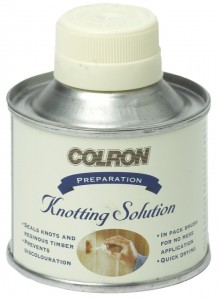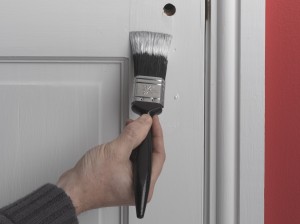Which paint for wood?
Which paint you use for painting wood can be a confusing dilemma when faced with the options available in your local DIY outlet. My advice is to bring things back to basics, as fundamentally, there are three paint types you use for painting wood, and all the options out there can be classified in these three groups. One of the main problems encountered is that paint, in general, is divided into oil-based (solvent-based) and water-based options. Generally, you choose one option or the other for your paint system, but there can be exceptions to this, as mentioned in the guide below.
The following information should therefore make your next visit to your DIY store slightly less overwhelming when you you need to choose which paint to use when painting the wood in your home.
Wood primer

Knots require sealing with knotting solution, or alternatively use Zinnser BIN which knots and primes all in one.
All bare wooden surfaces must be primed before any further coats are applied. Primer basically seals the wooden surface providing an even base for further coats. However, if the wood has any knots, they must be sealed with a knotting solution before the primer is applied. In general, knotting solution, or knotter, needs two coats. On the shelves of your store you will see a number of primers and I’ll try to detail the pros and cons of each.
- Wood Primer (oil-based) – Excellent product that provides a perfect base, but because it is oil-based, it smells awful, and generally takes at least 18 hours to dry.
- Primer Undercoat (water-based) – I would argue that primer undercoat is slightly less hardwearing than an oil based primer, but is this really a problem if you’re covering this with further paint layers? The answer is probably no. The wood may be slightly more susceptible to paint chipping away than would be the case if an oil-based primer is used, but not much more. Great product, quick drying and as the name suggests, it has an ‘undercoating’ roll to play in your paint system (just hold that thought, until we get to the undercoat section).
-

Methylated spirits is needed for cleaning up after using Zinsser BIN.
Primer Sealer (oil-based or water-based) – This area can create a lot of confusion, as you will see primer sealers for wall and ceiling surfaces, as well as wood. I am not talking about the wall options here, and generally you can spot them as they’re in larger tubs and tins, and may have terms such as ‘wall sealer’ or ‘plaster sealer’ written on the packaging. Ignore these, they’re not for wood, and generally you don’t need them for walls and ceilings, but that’s another story. I’ll be product specific here, as the best primer sealer you can buy is Zinsser BIN. Although it is oil-based, it is very quick drying, and because it contains Shellac, you can also use it as a knotter; therefore, it’s a product that knots and primes in one. But be aware that cleaning up requires methylated spirits, rather than white spirits, and it doesn’t smell very nice!
Your choices, are therefore these three. Personally I always use a primer sealer, and normally Zinsser BIN for the reasons mentioned, and for these very reasons, it gets into my ‘Top 10 of DIY’. Remember, you only need a primer if you’re painting bare wood.
Undercoat
This can certainly be an area of confusion, but basically all paint systems need an ‘undercoat’ between the primer and top coat. Now the reason undercoat is in inverted commas is that you may not actually use anything called undercoat for this purpose. Before I confuse you any further, hopefully the following ‘undercoat’ choices will provide the answers.
- Primer Undercoat (water-based) – Yes, exactly the same product as already mentioned in the primer section above. Therefore you apply a second coat of primer undercoat as an undercoat, if you intend to apply a gloss finish to your woodwork. You do not need to apply this second coat to your woodwork if your top coat is going to be an eggshell finish or a satin finish.
- Undercoat (oil-based) – Classic, oil-based undercoat is used over the top of primer and before oil-based gloss is applied to wood.
- Undercoat (water-based) – Fairly new product to the market that you now see on the shelves. A manufacturer may advise using it on primed surfaces before applying water-based gloss as your top coat(s). My advice would be don’t bother, just use the primer undercoat.
- Eggshell (water-based or oil-based) – Eggshell is the most matt (dull) of all top coats, or finishing paints, but although it will provide the top coat as well, you also use it as an undercoat.
- Satin (water-based or oil-based) – Satin occupies the sheen option area between matt and gloss. In other words it is less shiny than gloss, but more shiny than eggshell. As with an eggshell finish system, the first coat of satin is the ‘undercoat’.
Top Coat

Water-based paint systems will generally require more coats than their oil-based, traditional, counterparts. Water-based are much more user-friendly though!
There are three top coat finishes, and anything else you see on the shelves is a version of these – two of which I’ve already mentioned above in their undercoating roles.
- Gloss (oil-based or water-based) – Oil based gloss can be applied over the top of your oil-based undercoat and normally only one coat is required. Water-based gloss can also be applied over an oil-based undercoat, but if you have chosen the water-based route, then you will normally be applying it over your water-based primer undercoat. Two coats of water-based gloss is normally preferable, and notice that following a water-based system as a whole, tends to require more coats than following an oil-based gloss finishing system.
- Eggshell (oil-based or water-based) – You simply apply a top coat of eggshell over the previous eggshell coat.
- Satin (oil-based or water-based) – As with the eggshell system, you just apply your second satin coat over the previous satin coat.
Hopefully the above explanations will help you decide which paint you require for painting the wood in your home. There may be some product specific exceptions to the information, but in general most wood paints will fit into the above categories. The one major omission I have made is that of any sort of one-coat gloss product. In my opinion, they don’t work, never have, and so I’m never happy about giving advice on their use. Also, although I’ve mentioned you only need primer on bare wood, it’s possible that you may have found it necessary to power sand previously painted wood surfaces revealing areas of bare wood. In this case, the best course of action is to apply a primer undercoat, or primer sealer, that gets you back to a position for undercoating, followed by top coating the wood in the usual way.
One final point – how do you tell if a paint is water-based or oil-based? A lot of manufacturers don’t bother with clear labeling in this area. Basically, if you look on the back of the can, if it tells you to wash brushes with water……. yes you’ve guessed it. If it says use white spirit (or turps) for cleaning up, then it’s what can be classified oil-based. Also some oil-based paints will use different solvents such as the Zinsser BIN (methylated spirits).
